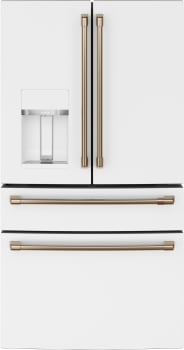GE 27.7 cu. ft. French Door Refrigerator in Fingerprint Resistant Stainless Steel, ENERGY STAR
LED lighting makes items easy to spot and retrieve. Food stays fresh longer with Twin Chill evaporators. Resists fingerprints and smudges for a clean sleek appearance.
GE appliances provide up-to-date technology and exceptional quality to simplify the way you live. With a timeless appearance, this family of appliances is ideal for your family. And, coming from one of the most trusted names in America, you know that this entire selection of appliances is as advanced as it is practical.
-
Second icemaker option – Always have extra ice on hand with an optional second icemaker in the freezer (IM5D kit sold separately)
- Space-saving icemaker – Located on the door with integrated bins to create more usable storage space
- Advanced water filtration uses RPWFE replacement filter – Reduces trace pharmaceuticals from water and ice ( Removes 98% of ibuprofen, atenolol, fluoxetine, progesterone and trimethoprim. These pharmaceuticals are not necessarily in all users’ water)
- Showcase LED lighting – Positioned throughout the interior and under fresh food doors to spotlight foods inside the refrigerator and in the freezer
- TwinChill evaporators – Separate climates in the fresh food and freezer sections help keep foods fresh
- Two humidity-controlled drawers and full-width drawer with LED light – Create the right environment for keeping fruits and vegetables fresh, while easily storing wider items like a party platter or a sheet cake
- Turbo Cool and Turbo Freeze settings – An extra boost of cold air restores interior to set temperature for optimum food freshness
- 27.7 cu. ft. of total capacity
- Approximate Dimensions (in.) – 69-7/8 in. H x 35-3/4 in. W x 36-1/4 in. D
- Limited 1-year entire appliance warranty
Additional information
| Depth (Excluding Handles) | 34.75 |
|---|---|
| Depth (Including Handles) | 36.25 |
| Depth (Less Door) | 29.38 |
| Depth With Door Open 90 Degrees (In) | 48.38 |
| Height to Top of Door Hinge (in.) | 69.88 |
| Height to Top of Refrigerator (in.) | 69 |
| Product Depth x Height x Width (in.) | 36.25 x 69.88 x 35.75 |
| Refrigerator Width (In.) | 35.75 |
| Certifications and Listings | ADA Compliant,Energy Star,UL Listed |
| Manufacturer Warranty | Limited 1-year entire appliance |






by Mike
We moved into our house in April 2020. The original Fridge was a LG that stopped working in December 2020. It was a blessing in disguise because this fridge is so much better! Tons of room, easy to use water filter for my kids and best of all, it doesn’t leave finger prints all over! Would highly recommend!
by John
This fridge has room for everything. It is so spacious and open. I can fins everything I need. After a full food shop run I still have space. Ice maker is wonderul. Only thing I dislike is doors don’t shut automatic. Need to really be pushed. Freezer has gett space as well. Was going to get he bugger version. So glad we upgraded to this. Love my new fridge.
by Ted
Fridge works great, install team was very professional. I am very happy there is so much space in this fridge I can fit everything with space for the unexpected to spare!
by Lori
I like this refrigerator. It is very similar to the previous one that I replaced with this one. In fact, I still have the other one out on my sunporch and it is still running fine after 12 years. I do like the new placement of the ice maker in the door, so it doesn’t take up as much refrigerator space but the ice production does seem slow and we often don’t have any. A few features that I wish this unit had: 1. the flip open butter shelf in the door (I had to buy one aftermarket) 2. Backlighting for the ice/water dispenser. I feel this was a BIG failing on GE’s part. The only thing that lights up regularly is a line on top of the selected feature (water, crushed, cubed) yet you can’t even read what feature you are using. My kitchen lighting isn’t the best but my brother is also legally blind and can’t read the unlit features. As you can see from the attached photo, there is backlighting for the warning lights and it makes it so easy to read but you can’t see much else. I really with GE would fix this.
by Moen
Love our new frig, lots of room and looks amazing.
by Sassy
We love everything about GE products. We have had the appliances for a short time and still getting use to using the all the appliances. I’m in love with my appliances.
by Chris
We love our new fridge! It is black slate snd doesn’t show fingerprints like other models we seen in the show room. We love it!!!